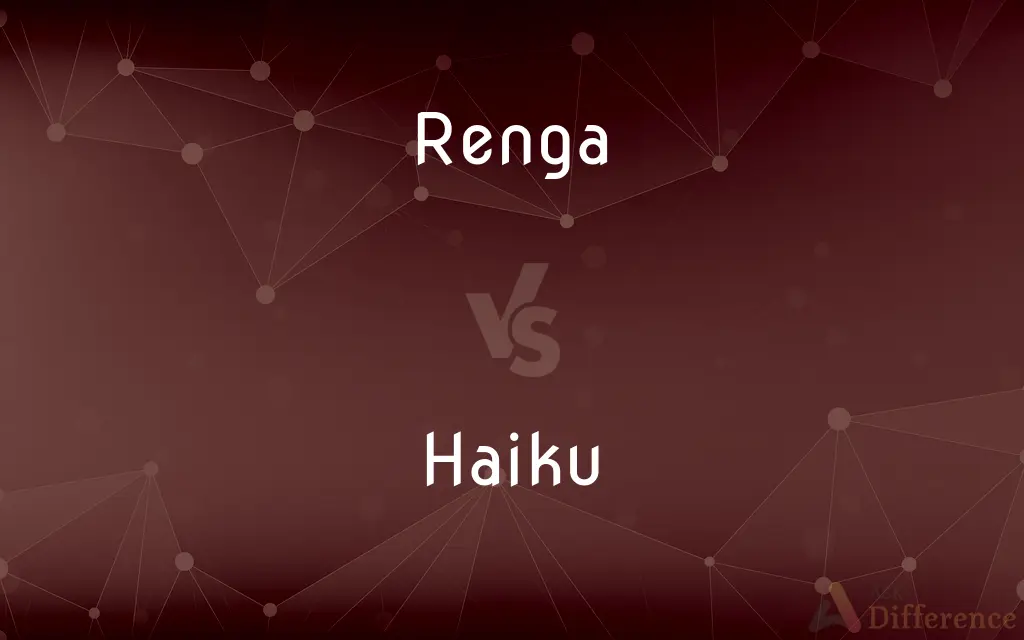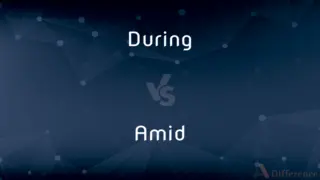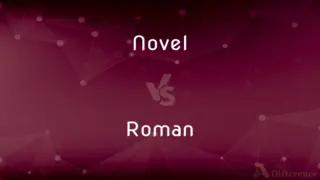Renga vs. Haiku — What's the Difference?
Edited by Tayyaba Rehman — By Fiza Rafique — Updated on May 1, 2024
Renga is a collaborative form of linked verse poetry, while Haiku focuses on individual 17-syllable poems capturing nature and moments.

Difference Between Renga and Haiku
Table of Contents
ADVERTISEMENT
Key Differences
Renga, traditionally a Japanese collaborative poetry, involves multiple poets adding stanzas to a master verse. On the other hand, Haiku is a solitary form where an individual composes a three-line poem typically adhering to a 5-7-5 syllable count.
Renga poems are structured around linking and shifting, where each stanza connects to the previous yet introduces a new element. Whereas Haiku concentrates on capturing a single moment in nature, emphasizing simplicity and depth within its brief structure.
The creation of Renga encourages social interaction and collective creativity, as poets respond to each stanza. In contrast, Haiku is often a personal, introspective exercise, reflecting the poet's connection with the natural world.
Renga can be of considerable length, sometimes consisting of 100 stanzas or more. On the other hand, Haiku is concise, always limited to just three lines, making it a quick, poignant expression.
The thematic freedom in Renga allows poets to explore various subjects through their verses. Conversely, traditional Haiku focuses more narrowly on seasons, nature, and the interplay between nature and humanity.
ADVERTISEMENT
Comparison Chart
Form
Collaborative, multiple authors
Individual, single author
Structure
Series of linked stanzas
One three-line stanza
Syllable Count
Variable, not fixed per stanza
Fixed, 17 syllables (5-7-5)
Focus
Thematic and stylistic shifts
Capturing a moment in nature
Cultural Role
Social and interactive poetry
Personal reflection and nature depiction
Compare with Definitions
Renga
Collaborative poem.
The renga at the poetry workshop was composed by ten different poets.
Haiku
Three-line poem.
She wrote a haiku about the silence of snowfall.
Renga
Linked verse.
Each verse in the renga links back to the previous one, adding layers of meaning.
Haiku
17-syllable structure.
His haiku, structured in 5-7-5 syllables, captured the dawn perfectly.
Renga
Multi-author creation.
A renga often reflects diverse poetic voices and styles.
Haiku
Seasonal reference.
Her autumn haiku beautifully expressed the loneliness of shorter days.
Renga
Long-form poetry.
Our renga extended to over 150 stanzas by the end of the session.
Haiku
Momentary capture.
The haiku depicted the exact moment the cherry blossom petals began to fall.
Renga
Shift and link.
The renga required each participant to cleverly shift the theme while linking to the last line.
Haiku
Nature focus.
A haiku often reflects profound observations about nature.
Renga
Renga (連歌, linked verse) is a genre of Japanese collaborative poetry in which alternating stanzas, or ku (句), of 5-7-5 and 7-7 mora (sound units, not to be confused with syllables) per line are linked in succession by multiple poets. Known as tsukuba no michi (筑波の道 The Way of Tsukuba) after the famous Tsukuba Mountain in the Kantō region, the form of poetry is said to have originated in a two-verse poetry exchange by Yamato Takeru and later gave birth to the genres haikai (俳諧) and haiku (俳句).The genre was elevated to a literary art by Nijō Yoshimoto (二条良基, 1320–1388), who compiled the first imperial renga anthology Tsukubashū (菟玖波集) in 1356.
Haiku
Haiku (俳句, listen ) is a type of short form poetry originally from Japan. Traditional Japanese haiku consist of three phrases that contain a kireji, or "cutting word", 17 on (a type of Japanese phoneme) in a 5, 7, 5 pattern, and a kigo, or seasonal reference.
Renga
A form of Japanese verse in which short poems are connected together. Encompasses haikai, the origination point for haiku.
Haiku
A Japanese lyric verse form having three unrhymed lines of five, seven, and five morae, traditionally invoking an aspect of nature or the seasons.
Haiku
A verse form in another language modeled on the Japanese haiku, typically counting syllables instead of morae.
Haiku
A poem written in this form.
Haiku
A Japanese poem in three lines, the first and last consisting of five morae, and the second consisting of seven morae, usually with an emphasis on the season or a naturalistic theme.
Haiku
A three-line poem in any language, with five syllables in the first and last lines and seven syllables in the second, usually with an emphasis on the season or a naturalistic theme.
Haiku, a poem
Five beats, then seven, then five
Ends as it began.
Haiku
An epigrammatic Japanese verse form of three short lines
Common Curiosities
Are there any syllable requirements for Renga?
Unlike Haiku, Renga does not have fixed syllable requirements for each stanza.
What is the main difference between Renga and Haiku?
Renga is a collaborative, linked-verse poetry form, while Haiku is a solitary, three-line poem focusing on nature.
How many poets are involved in creating a Renga?
Typically, two or more poets collaborate to write a Renga.
What themes do Haiku usually explore?
Haiku traditionally explores themes related to nature, seasons, and the interaction between nature and humanity.
Is Haiku only a Japanese form?
While originating in Japan, Haiku has become a popular poetic form globally.
What is the purpose of the 5-7-5 structure in Haiku?
The 5-7-5 structure in Haiku aims to provide a rhythmic and concise form to convey deep observations succinctly.
Can Renga address modern themes?
Yes, while traditional Renga often focuses on nature and seasons, modern Renga can explore a wide range of contemporary themes.
Can Haiku be part of a Renga?
Yes, a Haiku can serve as the opening stanza (hokku) of a Renga.
How long can a Renga be?
A Renga can be quite long, often consisting of 100 or more stanzas.
Do all Haiku need to include a seasonal word (kigo)?
Traditionally, yes, but modern Haiku sometimes strays from this rule.
Share Your Discovery

Previous Comparison
During vs. Amid
Next Comparison
Novel vs. RomanAuthor Spotlight
Written by
Fiza RafiqueFiza Rafique is a skilled content writer at AskDifference.com, where she meticulously refines and enhances written pieces. Drawing from her vast editorial expertise, Fiza ensures clarity, accuracy, and precision in every article. Passionate about language, she continually seeks to elevate the quality of content for readers worldwide.
Edited by
Tayyaba RehmanTayyaba Rehman is a distinguished writer, currently serving as a primary contributor to askdifference.com. As a researcher in semantics and etymology, Tayyaba's passion for the complexity of languages and their distinctions has found a perfect home on the platform. Tayyaba delves into the intricacies of language, distinguishing between commonly confused words and phrases, thereby providing clarity for readers worldwide.
















































